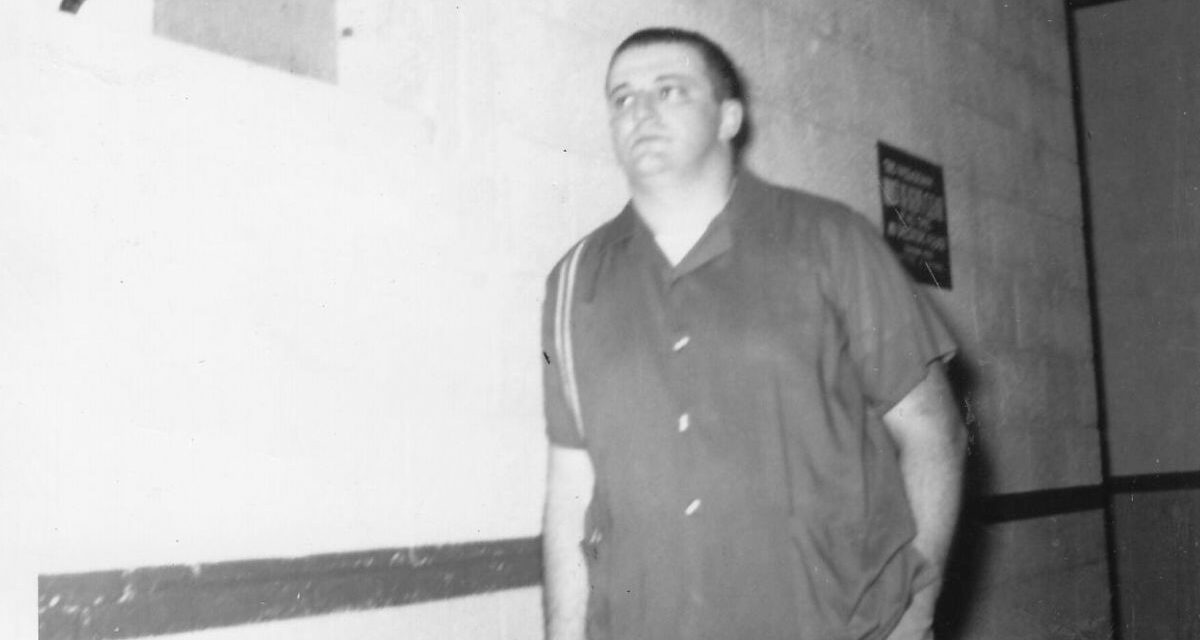Can a photo foretell the future? The photo at the top of this sad tale has “Tarzan” Frank Hewitt looking off into nothingness, his face blank, emotionless.
It was taken in May or June 1958, in London, Ontario. He’d be dead by the end of the year, at the age of 38.
* * *
Frank Hewitt was the son of Frank Hewitt and Nellie Pipher of Ringwood, Ontario, a small community east of what is now Stouffville. He attended public school in Ringwood, and then went to high school in Stouffville.
Like many young Canadians, Hewitt played hockey, and grew into a 6-foot-1, 245-pound man.
But first, there was a stint in the Canadian Army near the end of the Second World War. Wrestling must have already been on his mind, as there’s a record of him facing Al “Bunny” Dunlop in a bout at Camp Borden, a Canadian Forces Base, west of Barrie, Ontario, in June 1944. The earliest bout dug up for Hewitt was on January 4, 1944, at Hamilton, Ontario’s Municipal Pool, where he lost to Pat Flanagan.
Hewitt starts appearing on wrestling shows on a regular basis after the war. A Rochester, New York, preview for a show, on June 26, 1945, reads “newcomer to the local ring Frank Hewitt, 6-foot-3-inch ex-soldier who recently received his Army discharge after a two-year hitch.”
Somehow, he became a cowboy overnight, at least for a Hagerstown, Maryland, card on October 24, 1945: “Frank Hewitt, ‘Texas Cowboy’ who has gained quite a reputation in the wrestling game but little of it in the United States, doing the most of his grappling throughout Canada and England.”
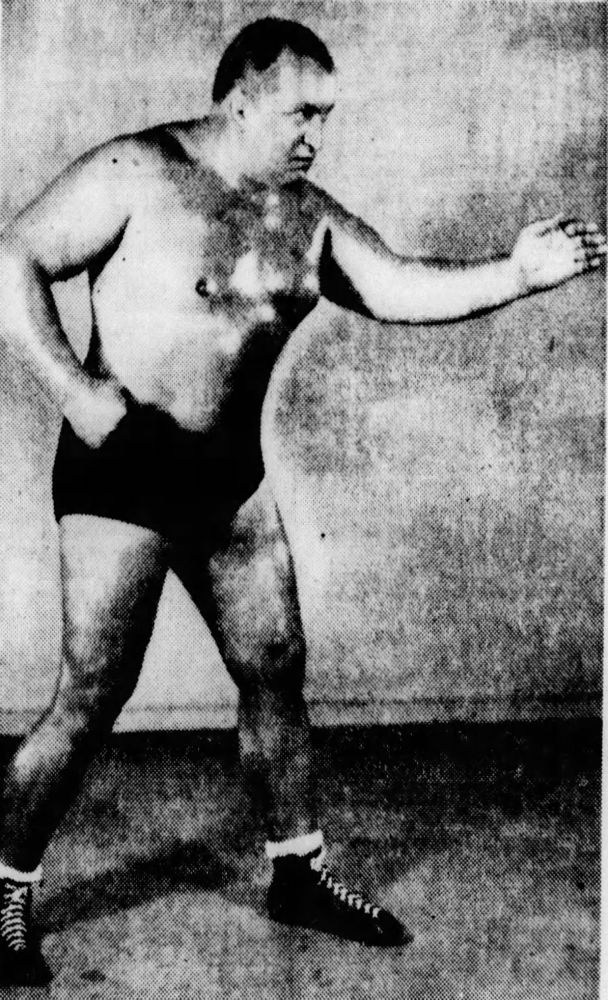
Frank Hewitt in 1946.
In 1946, “Big” Frank Hewitt kept traveling — Minnesota and Illinois in the first part of the year, and by April, he was making his debut in the US South, in Norfolk, Virginia. In the fall, Hewitt was in the Kansas territory.
His hometown newspaper, the Stouffville Tribune, proudly shared his progress with the locals. From the September 5, 1946, edition:
Former Ringwood Lad Home from Madison Sq Gardens
Professional wrestler Frank Hewitt who lived with his uncle Ralph Burkholder and attended Stouffville High School just before war broke out, was in town last week. Taking an enforced holiday because of a broken jaw, Frank is very good on the talk with his two jaws tied so tightly together that you couldn’t work a toothpick between them.
He has been living on liquids fed through a tube inserted at the back of his jaws. Nevertheless, this big boy weighing 250 pounds has only dropped 20 pounds in six weeks, and the encased jaws will be freed this week. Frank received the jolt that broke his lower jaw while in the ring down in Delaware, wrestling the famous Bob Strangler Wagner. He has appeared in Madison Square Gardens, New York and other famous ring stages during the war years, and is looking forward to the time when he will be fit for duty again. Frank is living in Toronto.
Years later, he was still a local celebrity. In May 1954, the Tribune reported that “Mr. Frank Hewitt of New York City called on his uncle and aunt, Mr. and Mrs. Ralph Burkholder, and other friends in Ringwood on Saturday evening.” Then a couple of weeks later, his exploits merited mention: “Viewers of TV last week may have watched Mr. Frank Hewitt wrestling down in Buffalo. At the end of the bout it was necessary to call in the police reinforcements to escort Hewitt from the ring. Frank Hewitt is a former resident of Ringwood and visited here a couple of weeks ago.”
The arrival of television was a boon to Hewitt, who started adding the “Tarzan” nickname in the early 1950s, but before that he was “Bad Man” Hewitt in some places — like Oshawa, Ontario.
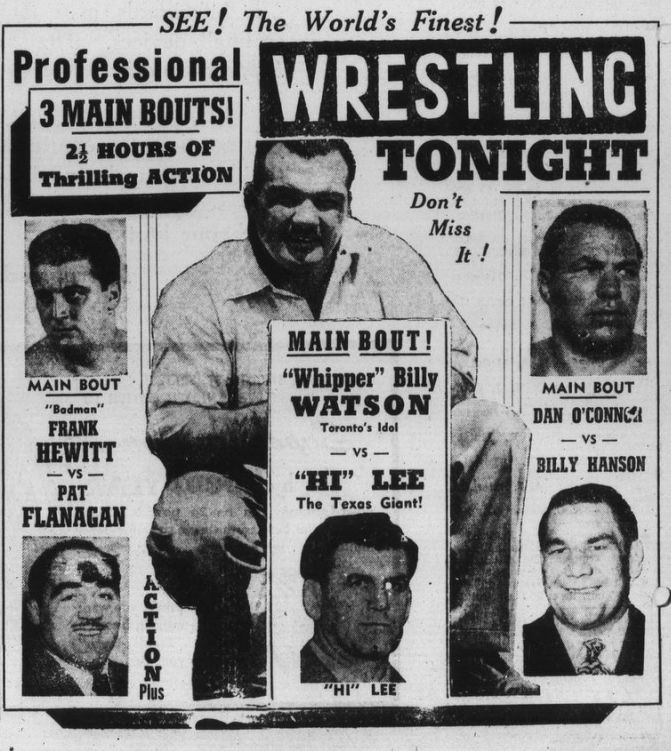
A newspaper ad for a card on June 28, 1949, in Oshawa, Ontario.
The Kingston (NY) Daily Freeman warned fans that he was coming to town on January 26, 1951: “Hewitt, who is recognized as the top television wrestling star, is one of the dirtiest men in the game. His rough tactics and villainous technique have caused him to be hated by wrestling fans everywhere and everyone wants to see him get his block knocked off.” Four years later, the Alabama Courier was saying essentially the same thing: “Hewitt is one of the roughest and toughest mat stars in the game, and stops at nothing to win his matches.”
The Charlotte News reported knifing of “Rowdy” Hewitt by a fan on October 20, 1947. He “suffered superficial lacerations” at the Charlotte Armory, after his no contest battle with Jack Hader. The article described the melee:
Hewitt, never popular with the crowd during previous appearances here, antagonized those near the ringside by taking a station near the corner of the ring inside a wooden railing after donning street clothes. When he repeatedly attempted to help wrestler Wally Dusek against Ray Villmer in the main event, the crowd surged forward and grabbed him before he could climb into the comparative safety of the ring.
Stripped of his trousers, Hewitt sought refuge under the ring itself and before police could reach him and escort him to the safety of the dressing room, he was severely cut on his legs and back by a sharp instrument. Although he had previously put his wallet in safekeeping, Hewitt lost his watch and several important papers during the melee.
The crowd milled around the ring for several minutes, several attempting to stage impromptu fights with Dusek and Referee Marvin Hutchens before quiet was restored.
* * *
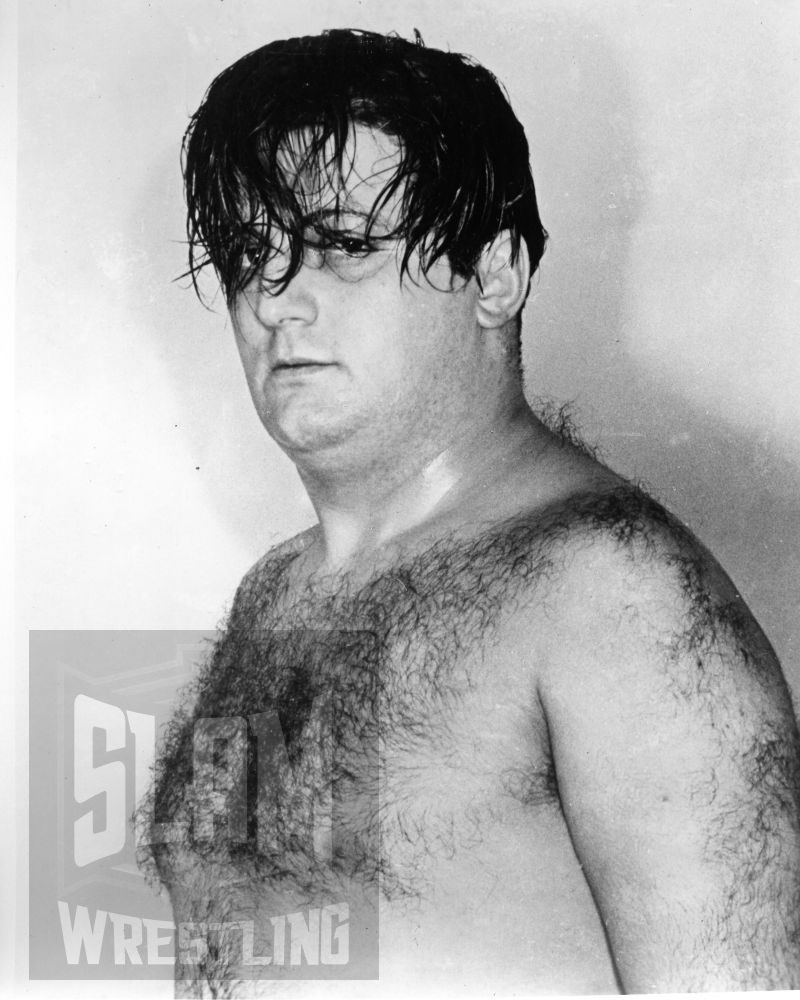
Frank Hewitt with the messy hair look — Tarzan-like? Courtesy the collection of Chris Swisher
Like many wrestlers during the territorial era, Hewitt was everywhere and fought seemingly everyone at one point. There he is against Buddy Rogers … against a young Dick Beyer (the future Destroyer) … taking on Lou Thesz … the heroic Fred Blassie … or battling fellow Canadians down in the U.S., like Chris Tolos.
By 1955, he settled in Nashville, Tennessee, marrying a local woman, Virginia Vradenburg. Hewitt is on countless shows within a reasonable drive of home from that point on — except when he’d go home.
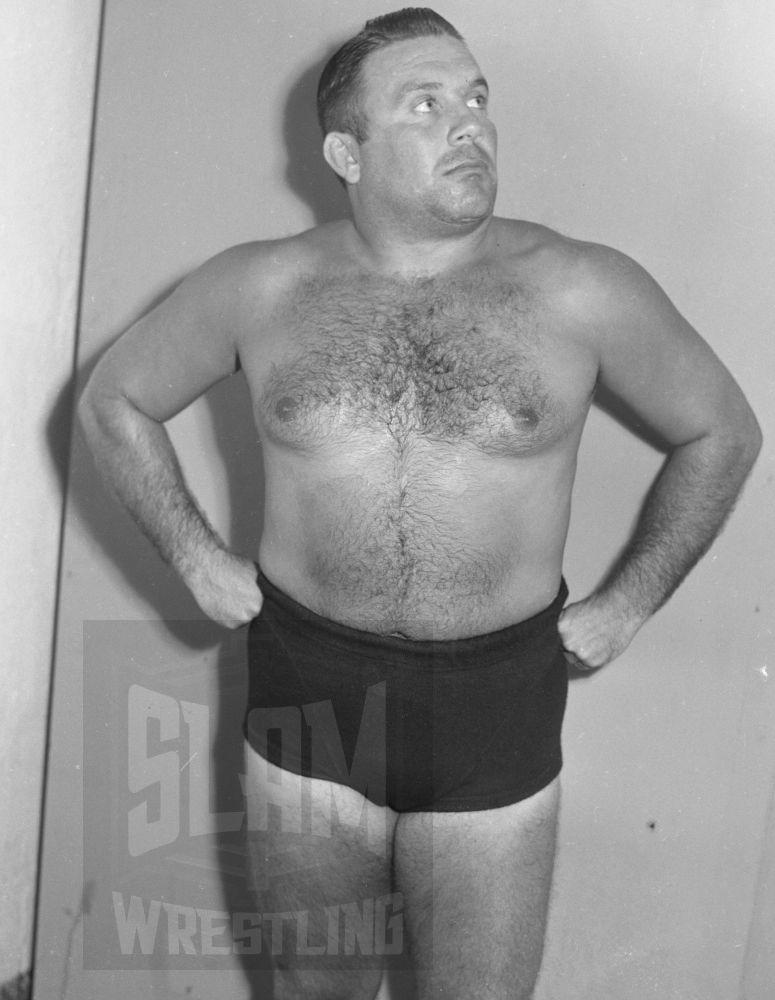
Frank Hewitt strikes a pose. Courtesy the collection of Chris Swisher
It appeared that he tried to make it back to southern Ontario every summer, usually in May or June, based on the cards he was on in the surrounding area, Buffalo or Niagara Falls, up to Oshawa, or the notes in the Stouffville paper. A working holiday of sorts.
His last Ontario appearance appears to be on Friday, June 27, 1958, at the Milton Arena, where he lost to the towering Paul Bunyan, on a card headlined by Whipper Billy Watson beating Ivan Kalmikoff in two out of three falls.
Hewitt headed home to Tennessee, but abruptly stopped wrestling in the fall. Doctors told him that he had a heart condition.
* * *
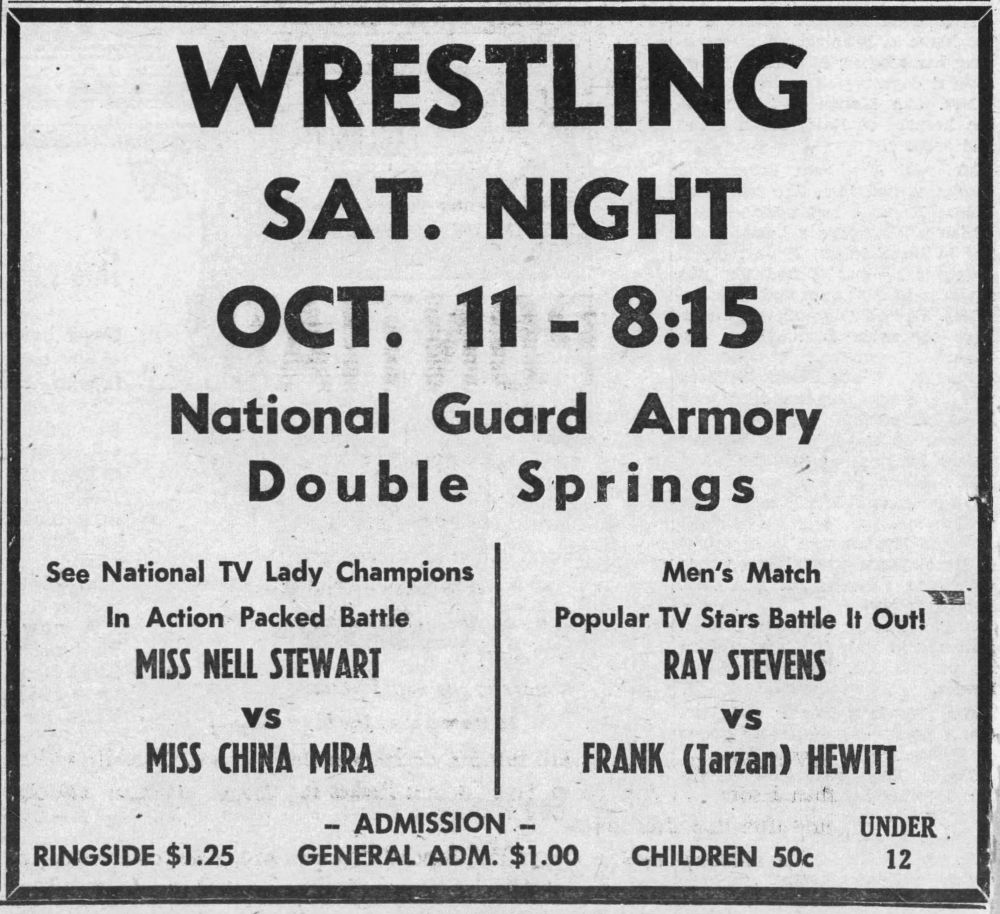
One of Frank Hewitt’s last appearances was likely this October 10, 1958, card in Haleyville, Alabama.
With their two sons, Rickie Ray and Bobby Ray, Frank and Virginia Hewitt lived at 221 Chapel St. in Nashville.
We know that because that’s where the emergency services were called on the morning of Monday, December 22, 1958.
Hewitt had gone to bed early, complaining of an upset stomach. His wife found him on the side of the bed in the morning, dead.
Services, run by the Phillips-Robin Funeral Home, were on December 23, and he was interred at the Spring Hill cemetery. The Stouffville Tribune, in its Christmas Eve edition, reported that “Mrs. Ralph Burkholder of Stouffville, an aunt, and Mrs. Stanley Fleming of Toronto, a sister, are flying today to attend the funeral.”
* * *
Very little was ever written about Frank “Tarzan” Hewitt and his life and times. He didn’t hold a ton of title belts, wasn’t a superstar by any means.
Ed Hayes, the sports editor of the Blytheville Courier News in Arkansas, saw fit to mention Hewitt’s death in his column, “The View From Here”:
THE MURDEROUS MOOD of the wrestling audience was sobered somewhat at Legion Arena Monday night with a death announcement.
The report said FRANK (TARZAN) HEWITT was the man who had recently died . . . a wrestler whose face and bulk were familiar to a legion of Legion fans.
Tarzan was always the villain … but somehow you’re inclined to forget that when a man slips off into eternity.
He was a young man, too.
But he was engaged in an uphill profession that is, despite its show, frequent unsportsmanlike deportment, and spasmodic sham, a violent way to make a living.
If the ring doesn’t get to a wrestler sooner or later in some manner, the highway often does.
“That traveling is the worst part of the whole profession,” said HERB WELCH, Blytheville’s new promoter.
Incidentally, Herb got his start in Blytheville … about 20 years ago . . . as a light heavyweight.
TOP PHOTO: “Tarzan” Frank Hewitt in London, Ontario, circa May or June 1958. Terry Dart Collection
